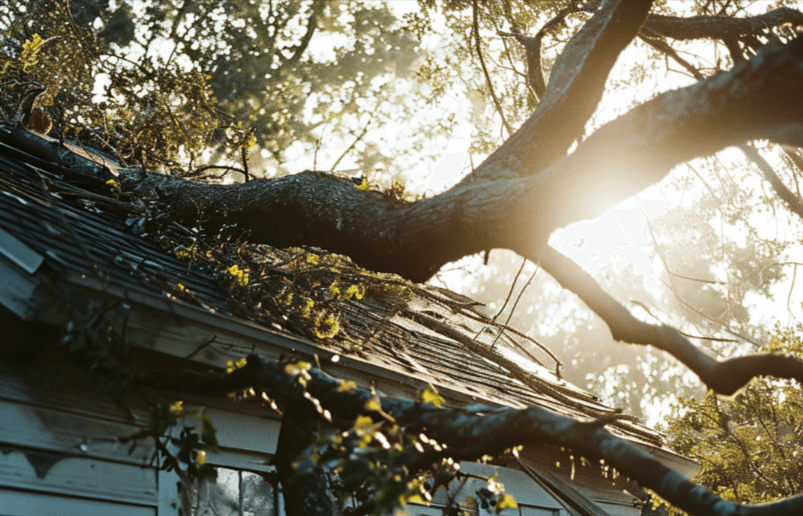
For the average homeowner who discovers damage to their roof, the immediate thought is often to file an insurance claim. However, the decision is not always that straightforward. One key concern is the potential impact of a roof claim on insurance premiums.
Understanding Homeowners Insurance and Roof Claims
Basics of Homeowners Insurance: Homeowners insurance is designed to offer financial protection against various types of damage to your property, including structural damage to the roof. Coverage typically includes events like storms, fire, and other unforeseen incidents. However, the extent of the coverage can vary based on the policy details and the insurance provider.
Common Causes for Roof Claims: Roof claims are often filed due to damage from natural events such as severe storms, hail, or wind. Other common causes include damage from fallen trees or branches and deterioration due to age or lack of maintenance. Understanding the specific coverage in your policy for these scenarios is crucial, as some policies might exclude certain types of damage or offer limited coverage based on the roof’s age or condition.
Factors Influencing Insurance Premiums After a Claim
When a homeowner files a claim for roof damage, several factors can influence whether or not their insurance premiums will increase:
- Nature and Frequency of Claims: Insurers often consider the frequency of claims filed by a policyholder. If you have a history of multiple claims, especially within a short period, this could be seen as a higher risk, potentially leading to increased premiums. The nature of the claim (e.g., weather-related damage vs. lack of maintenance) also plays a role.
- Cost of the Claim: Generally, the higher the cost of the claim, the more likely it is to impact your insurance premiums. Large claims can signal to insurers that your property may be at a higher risk for future claims, which they may compensate for by raising rates.
- Insurance Company Policies: Each insurance company has its own set of guidelines for determining premium increases. Some may offer a ‘first claim forgiveness’ policy, while others might increase premiums after any claim, regardless of its nature or cost.
Pros and Cons of Filing a Roof Claim
Deciding whether to file a roof claim involves weighing the immediate benefits against potential long-term costs. Let’s consider two fictional scenarios to illustrate this:
Scenario 1: Beneficial to File a Claim
Imagine Sarah, a homeowner whose roof suffered significant damage after a severe hailstorm. The cost of repairs is estimated at $8,000, well above her deductible of $1,000. Sarah decides to file a claim. Her insurance covers the bulk of the repair costs, allowing her to restore her roof to optimal condition without a substantial financial burden. In this case, filing a claim is beneficial as it saves Sarah from high out-of-pocket expenses for extensive repairs.
Scenario 2: Not Beneficial to File a Claim
On the other hand, consider John, who notices a few missing shingles on his roof, likely due to normal wear and tear. The estimated repair cost is $600, just slightly above his deductible of $500. John decides against filing a claim, considering the minor cost difference and the potential for his premiums to increase, which could cost him more in the long run. By paying out-of-pocket for this minor repair, John avoids the risk of higher future premiums.
Benefits of Filing: In cases of significant damage, especially when the repair costs far exceed your deductible, filing a claim can be financially beneficial. Insurance can cover substantial expenses that would otherwise be out-of-pocket, allowing for proper repairs and maintenance of your property’s value.
Drawbacks of Filing: Filing a claim for minor repairs can lead to increased premiums over time, which might cumulatively exceed the cost of the repair itself. Additionally, having a claim on your record, especially if it’s not the first, can affect your perceived risk and insurability in the future.
Strategies to Mitigate Premium Increases
Homeowners can adopt several strategies to minimize the risk of increased insurance premiums after filing a roof claim:
- Preventative Maintenance: Regularly maintaining your roof can prevent minor issues from escalating into major problems that require filing a claim. Routine inspections and timely repairs can extend the life of your roof and reduce the likelihood of damage that necessitates an insurance claim.
- Shopping for Insurance: It’s beneficial to periodically review and compare insurance policies. Some insurers may offer more favorable terms regarding claims and premium increases. When your policy is up for renewal, consider getting quotes from multiple providers to ensure you have the most advantageous coverage.
- Deductible Considerations: Opting for a higher deductible can lower your premium costs. However, this means you’ll pay more out-of-pocket in the event of a claim. Carefully assess your financial ability to handle higher upfront costs in exchange for potential long-term savings on premiums.
Conclusion
Filing a roof claim can indeed lead to an increase in your homeowners insurance premiums, but this isn’t always the case. The decision to file should be based on a thorough evaluation of the immediate need for repairs, the cost of the claim relative to your deductible, and the potential long-term financial implications. Ultimately though, understanding your policy and working closely with your insurance provider will guide you in making decisions that align with your financial and property maintenance goals.





